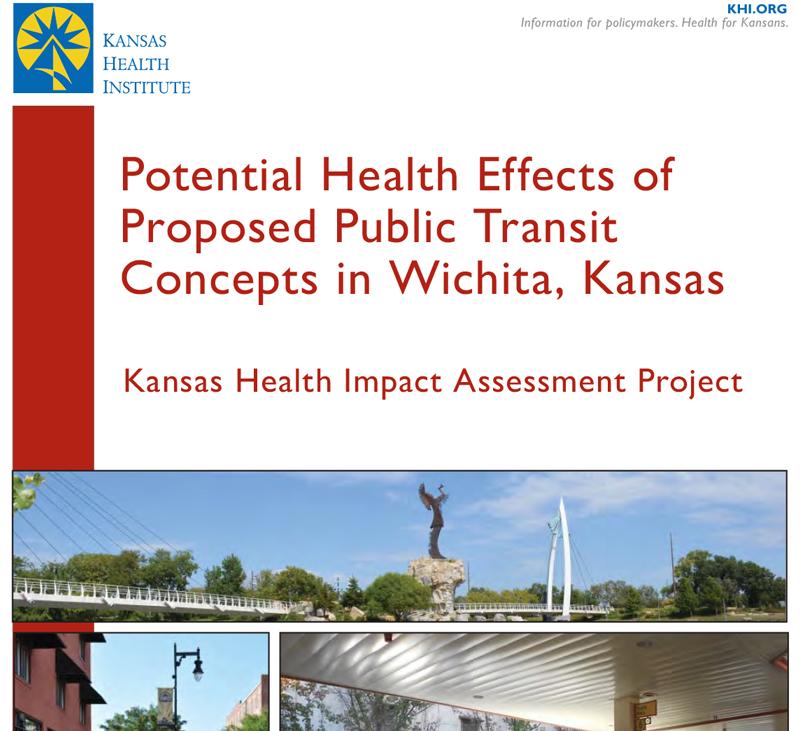A new report released today by the Kansas Health Institute examines how various public transit scenarios could affect the health of Wichita area residents.
A health impact assessment (HIA) is a type of study that helps decision-makers identify the likely health impacts of a decision in another field. As outlined in this report, the extent of the potential health effects will depend on which changes are made to the Wichita Transit System.
This HIA explored transit-related factors that influence health, including air quality, traffic-related injuries and secondhand smoke exposure, as well as access to employment, health care, food sources, educational and recreational resources. For example, increased access to services (e.g., employment, food sources) can result in a number of positive health benefits, including healthy food choices, preventive care and increased physical activity.
“The HIA findings and recommendations will help us to test what we have been doing right and what needs to be changed in order to meet the transit needs of Wichita residents,” says Steve Spade, director of Wichita Transit. “We look forward to working with the City Council and Transit Advisory Board to prioritize the recommendations into short term improvements and others to consider throughout the future transit planning process.”
Background on the Transit HIA
The HIA builds on the work completed by Olsson Associates, a consultant hired by the City of Wichita to develop improvement scenarios and conduct a community outreach study of needs and desired characteristics of transit in the Wichita area.
Results of the study were used to develop three transit concepts and two add-on options for connecting transit services to communities outside the City of Wichita.
The HIA used multiple information sources — including a review of relevant literature, secondary data analysis, interviews with local leaders and meetings with community members— to project potential health impacts associated with each of the proposed transit concepts:
-
- Grid,
- Optimization,
- Reduction,
- Extension, and
- Commuter.
“The information that is included in this report will be very important as decisions are made at the community level regarding Wichita transit services,” said Annette Graham, director of the Sedgwick County Department on Aging and a member of the HIA Advisory Panel. “This is a critical time for the report to be released. It looked at a number of different, very critical factors in our community related to transportation to be considered by decision-makers.”
The HIA team, directed by Tatiana Y. Lin of the Kansas Health Institute, considered three key questions related to the proposed transit proposals in Wichita:
-
- Will the proposed transit changes affect access to employment, health care, food sources and educational and recreational facilities?
- Will changes in access to these services improve the health of Wichita residents?
- How will a change in transportation mode from car to bus affect the health of Wichita residents?
The first proposal from the HIA report — a grid system known as Concept A — is more likely to produce a larger number of positive health effects associated with increased access to food sources, employment, health care and educational and recreational resources.
However, the extent to which the grid system will improve access to services and result in positive health effects will depend upon increased frequency and longer hours of operation.
Access to services can have a greater effect on vulnerable populations, such as the poor and elderly, because they may have less access to transportation outside of mass transit.
“The health impact assessment process helped us to re-engage around transit issues and identify opportunities for improving the quality of life for Wichita residents” said the Councilwoman Janet Miller.
Health Impact Assessments
HIAs are part of a fast-growing field in the United States. In 2007, there were only 27 such studies. Today, more than 275 HIAs have been completed or are ongoing. The Kansas Health Institute completed the first HIA in Kansas in 2012, as part of its mission to inform policymakers. The Kansas Health Institute was recently recognized by the National Network of Public Health Institutes as an emerging leader in this field and will develop a training center for HIA work in Kansas.
This HIA project is supported by a grant from the Health Impact Project, a collaboration of the Robert Wood Johnson Foundation and The Pew Charitable Trusts, and through funding from the Kansas Health Foundation.
